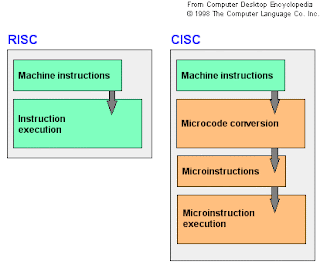Understanding Processor Architecture: RISC versus CISC
Popular processor designs can be broadly divided into two categories: Complex Instruction Set Computers (CISC) and Reduced Instruction Set Computers (RISC). The dominant processor in the PC market, Pentium, belongs to the CISC category. However, the recent trend is to use the RISC designs. Even Intel has moved from CISC to RISC design for their 64-bit processor.
CISC systems use complex instructions. For example, adding two integers is considered a simple instruction. But, an instruction that copies an element from one array to another and automatically updates both array subscripts is considered a complex instruction. RISC systems use only simple instructions. Furthermore, RISC systems assume that the required operands are in the processor’s internal registers, not in the main memory. It turns out that characteristics like simple instructions and restrictions like register-based operands not only simplify the processor design but also result in a processor that provides improved application performance.
Several factors contributed to the popularity of CISC in the 1970s. In those days, memory was very expensive and small in capacity. Even in the mid-1970s, the price of a small 16 KB memory was about $500. So there was a need to minimize the amount of memory required to store a program. An implication of this requirement is that each processor instruction must do more, leading to complex instruction set designs. Complex instructions meant complex hardware, which was also expensive. This was a problem processor designers grappled with until Wilkes proposed microprogrammed control in the early 1950s.
Figure 1. The ISA-level architecture can be implemented either directly in hardware or through a microprogrammed control.
A microprogram is a small run-time interpreter that takes the complex instruction and generates a sequence of simple instructions that can be executed by the hardware. Thus the hardware need not be complex. Once it became possible to design such complex processors by using microprogrammed control, designers went crazy and tried to close the semantic gap between the instructions of the processor and high-level languages. This semantic gap refers to the fact that each instruction in a high-level language specifies a lot more work than an instruction in the machine language. Think of a while loop statement in a high-level language such as C, for example. If we have a processor instruction with the while loop semantics, we could just use one machine language instruction. This explains why most CISC designs use microprogrammed control, as shown in Figure 1.
RISC designs, on the other hand, eliminate the microprogram layer and use the hardware to directly execute instructions. Here is another reason why RISC processors can potentially give improved performance. One advantage of using microprogrammed control is that we can implement variations on the basic ISA architecture by simply modifying the microprogram; there is no need to change the underlying hardware. Thus it is possible to come up with cheaper versions as well as high-performance processors for the same family of processors.
References
 |
| RISC vs. CISC: What is the differences? |
CISC systems use complex instructions. For example, adding two integers is considered a simple instruction. But, an instruction that copies an element from one array to another and automatically updates both array subscripts is considered a complex instruction. RISC systems use only simple instructions. Furthermore, RISC systems assume that the required operands are in the processor’s internal registers, not in the main memory. It turns out that characteristics like simple instructions and restrictions like register-based operands not only simplify the processor design but also result in a processor that provides improved application performance.
Several factors contributed to the popularity of CISC in the 1970s. In those days, memory was very expensive and small in capacity. Even in the mid-1970s, the price of a small 16 KB memory was about $500. So there was a need to minimize the amount of memory required to store a program. An implication of this requirement is that each processor instruction must do more, leading to complex instruction set designs. Complex instructions meant complex hardware, which was also expensive. This was a problem processor designers grappled with until Wilkes proposed microprogrammed control in the early 1950s.
Figure 1. The ISA-level architecture can be implemented either directly in hardware or through a microprogrammed control.
A microprogram is a small run-time interpreter that takes the complex instruction and generates a sequence of simple instructions that can be executed by the hardware. Thus the hardware need not be complex. Once it became possible to design such complex processors by using microprogrammed control, designers went crazy and tried to close the semantic gap between the instructions of the processor and high-level languages. This semantic gap refers to the fact that each instruction in a high-level language specifies a lot more work than an instruction in the machine language. Think of a while loop statement in a high-level language such as C, for example. If we have a processor instruction with the while loop semantics, we could just use one machine language instruction. This explains why most CISC designs use microprogrammed control, as shown in Figure 1.
RISC designs, on the other hand, eliminate the microprogram layer and use the hardware to directly execute instructions. Here is another reason why RISC processors can potentially give improved performance. One advantage of using microprogrammed control is that we can implement variations on the basic ISA architecture by simply modifying the microprogram; there is no need to change the underlying hardware. Thus it is possible to come up with cheaper versions as well as high-performance processors for the same family of processors.
References
- Guide to RISC Processors for Programmers and Engineers by Sivarama P. Dandamudi, Springer (2005), ISBN 0-387-21017-2.


Comments
Post a Comment